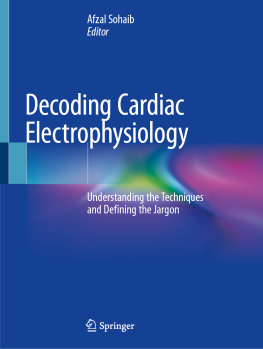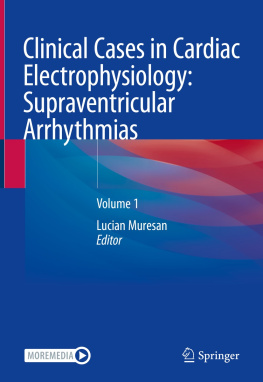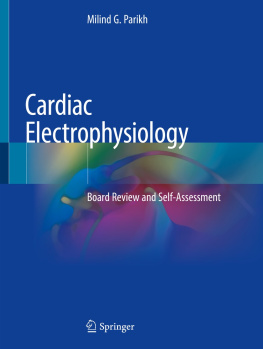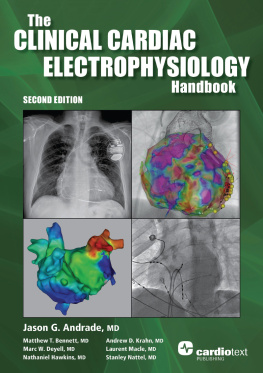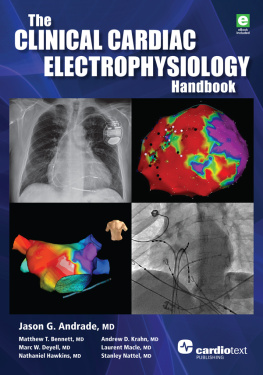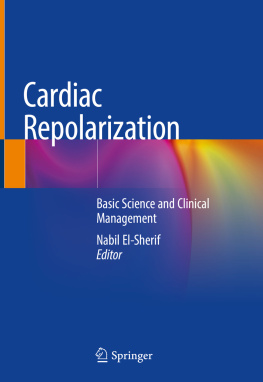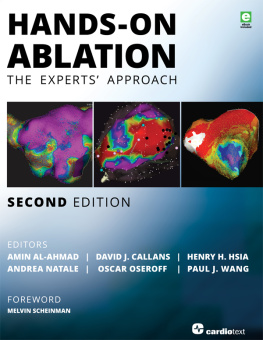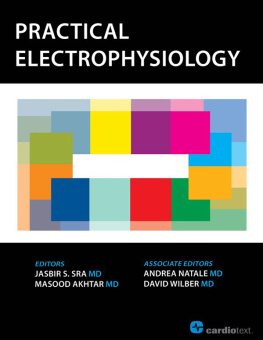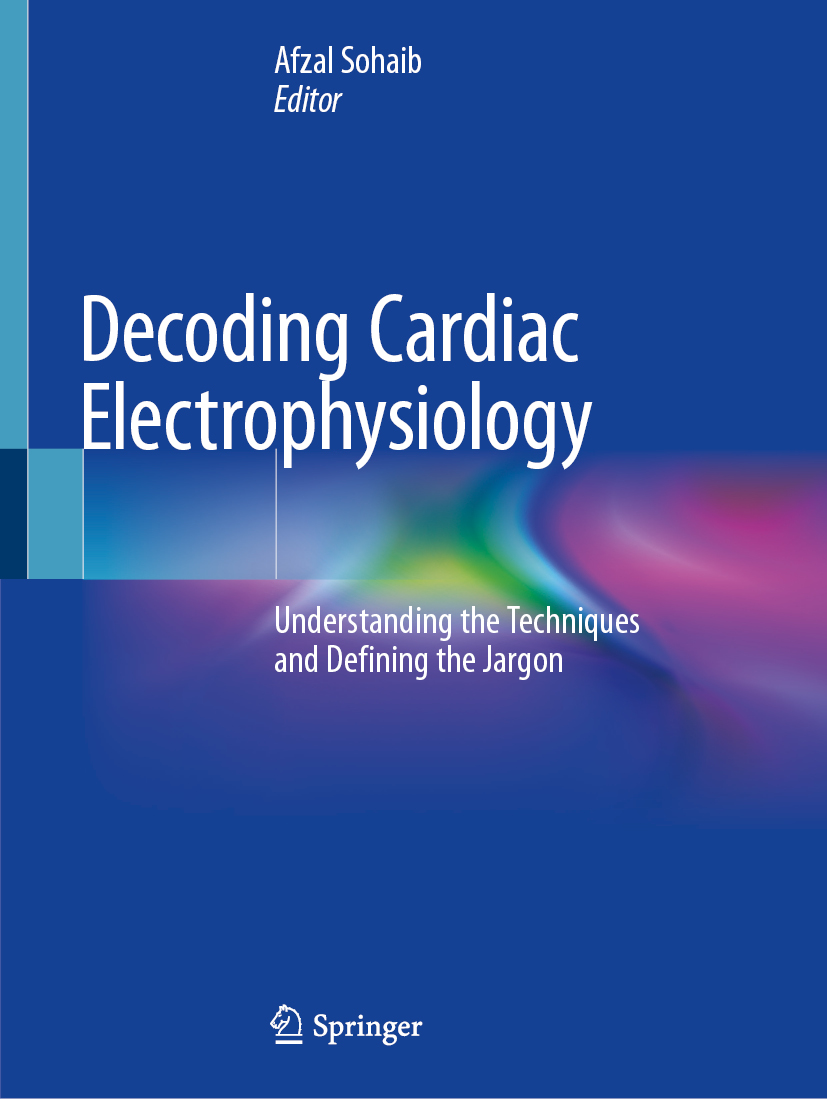Decoding Cardiac Electrophysiology
Understanding the Techniques and Defining the Jargon
Editor
Afzal Sohaib
St Bartholomews Hospital, London, UK
King George Hospital, Ilford, Essex, UK
ISBN 978-3-030-28671-2 e-ISBN 978-3-030-28672-9
https://doi.org/10.1007/978-3-030-28672-9
Springer Nature Switzerland AG 2020
This work is subject to copyright. All rights are reserved by the Publisher, whether the whole or part of the material is concerned, specifically the rights of translation, reprinting, reuse of illustrations, recitation, broadcasting, reproduction on microfilms or in any other physical way, and transmission or information storage and retrieval, electronic adaptation, computer software, or by similar or dissimilar methodology now known or hereafter developed.
The use of general descriptive names, registered names, trademarks, service marks, etc. in this publication does not imply, even in the absence of a specific statement, that such names are exempt from the relevant protective laws and regulations and therefore free for general use.
The publisher, the authors and the editors are safe to assume that the advice and information in this book are believed to be true and accurate at the date of publication. Neither the publisher nor the authors or the editors give a warranty, expressed or implied, with respect to the material contained herein or for any errors or omissions that may have been made. The publisher remains neutral with regard to jurisdictional claims in published maps and institutional affiliations.
This Springer imprint is published by the registered company Springer Nature Switzerland AG
The registered company address is: Gewerbestrasse 11, 6330 Cham, Switzerland
Contents
Part I The Tools for Understanding Cardiac Electrophysiology
Sandeep Prabhu and Afzal Sohaib
Jason V. Garcia and Daniel K. Y. Wan
Part II Standard Ablation
Jonathan M. Behar
Wei Yao Lim and Marco Baca
Kevin Ming Wei Leong
Part III Complex Ablation
Vishal Luther and George Katritsis
David Duncker , Johanna L. Mller-Leisse , Christos Zormpas , Jrg Eiringhaus and Christian Veltmann
Neil T. Srinivasan and Alex Cambridge
1. The Basic Language of Cardiac ElectrophysiologyAn Introduction to Intracardiac Electrograms and Electrophysiology Studies
This chapter aims to introduce the reader to some of the core principles which underpin clinical cardiac electrophysiology and how it is applied in cardiac catheter laboratories, where ablations take place. Key language and terminology are introduced before these concepts are explored further in subsequent chapters.
1.1 Cardiac ElectrophysiologyWhy the Mystique?
To the uninitiated, there is a perceived mystique about cardiac electrophysiology (EP) that often acts as a barrier to an even rudimentary understanding of EP procedures. Unhelpfully, this view of EP is not infrequently perpetuated by electrophysiologists themselves, with most apparently communicating in a language indecipherable, even to the seasoned general cardiologist. The purpose of this book is to simplify this jargon, and decode it into terms to allow newcomers to the field to find their way among the world of EP.
Unlike other realms of cardiology such as imaging, angiography and structural intervention, which have an obvious visual element (a regurgitant valve, a narrowed artery, etc.), electrophysiology instead relies upon the interpretation of electrical signals and the manner in which they propagate throughout the cardiac tissue. Since electricity itself cannot be physically visualised in real time, its presence and course through various cardiac structures instead needs to be inferred by the detection of electrical signals at various intra-cardiac sites. The direction and pattern of electrical wavefronts through tissue is determined by the timing of electrical signals in relation to each other, the surface ECG and/or a stable reference signal. For this reason, the language of electrograms needs to be comprehended before electrophysiological procedures can make sense. Fortunately, like any language, there are key fundamental principles and concepts which will aid the interested student in understanding and eventually becoming proficient in this language. This chapter focuses on describing these key concepts. Subsequent chapters will then apply these principles to the treatment of various commonly treated conditions.
Decoding the Jargon and Beyond the Basics
Electrophysiologists have a tendency to very quickly slip into using jargon. For this reason throughout the book, we have highlighted commonly used terms and described them in decoding the jargon boxes. Each chapter is structured so that the core concepts are the main focus and some of the more complex concepts are discussed in sections entitled beyond the basics towards the end of each chapter.
1.2 What Happens in the EP Lab
Before exploring some of these fundamental concepts it is useful to have an overview of the range of procedures which happen in the electrophysiology laboratory and the rest of the book will deal with each of these areas in detail. Procedures can be divided into standard EP and complex EP. This is an oversimplification and often what is classified as standard can be very complex and vice versa, but it is a useful way to orientate oneself, and these categories are frequently used by various bodies involved in overseeing electrophysiology [].
Standard EP usually refers to procedures which can deal with arrhythmias frequently from the right sided circulation and includes AV node ablation , AV nodal re-entry tachycardia (AVNRT), typical atrial flutter , and ablation of accessory pathways . These often can be done with a relatively simple arrangement of catheters and fluoroscopy. The risks are usually at the lower end, and procedure duration is usually at the lower end of the spectrum for electrophysiology procedures.
Complex EP usually refers to procedures with deal with arrhythmias from the left sided circulation and includes ablation for atrial fibrillation , left sided atrial tachycardias , and ventricular tachycardia (VT). Procedures tend to be slightly longer. Heparinisation is required as the left sided circulation is being instrumented. Consequently, the risks are at the higher or more serious end of the spectrum. Key elements of these procedures are described in Table .

